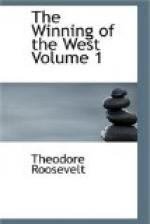3. Dr. Thomas Walker, of Virginia. He named them after the Duke of Cumberland. Walker was a genuine explorer and surveyor, a man of mark as a pioneer. The journal of his trip across the Cumberland to the headwaters of the Kentucky in 1750 has been preserved, and has just been published by William Cabell Rives (Boston: Little, Brown & Co.). It is very interesting, and Mr. Rives has done a real service in publishing it. Walker and five companions were absent six months. He found traces of earlier wanderers—probably hunters. One of his companions was bitten by a bear; three of the dogs were wounded by bears, and one killed by an elk; the horses were frequently bitten by rattlesnakes; once a bull-buffalo threatened the whole party. They killed 13 buffaloes, 8 elks, 53 bears, 20 deer, 150 turkeys and some other game.
4. Hunters and Indian traders visited portions of Kentucky and Tennessee years before the country became generally known even on the border. (Not to speak of the French, who had long known something of the country where they had even made trading posts and built furnaces, as see Haywood, etc.) We know the names of a few. Those who went down the Ohio, merely landing on the Kentucky shore, do not deserve mention; the French had done as much for a century. Whites who had been captured by the Indians, were sometimes taken through Tennessee or Kentucky, as John Salling in 1730 and Mrs. Mary Inglis in 1756 (see “Trans-Alleghany Pioneers,” Collis, etc.). In 1654 a certain Colonel Wood was in Kentucky. The next real explorer was nearly a century later, though Doherty in 1690, and Adair in 1730, traded with the Cherokees in what is now Tennessee. Walker struck the head-water of the Kentucky in 1750; he had been to the Cumberland in 1748. He made other exploring trips. Christopher Gist went up the Kentucky in 1751. In 1756 and 1758 Forts Loudon and Chisset were built on the Tennessee head-waters, but were soon afterwards destroyed by the Cherokees. In 1761, ’62, ’63 and for a year or two afterwards a party of hunters under the lead of one Wallen hunted on the western waters, going continually farther west. In 1765 Croghan made a sketch of the Ohio River. In 1766 James Smith and others explored Tennessee. Stoner, Harrod, and Lindsay, and a party from South Carolina were near the present site of Nashville in 1767, in the same year John Finley and others were in Kentucky, and it was Finley who first told Boon about it and led him thither.
5. The attempt to find out the names of the men who first saw the different portions of the western country is not very profitable. The first visitors were hunters, simply wandering in search of game, not with any settled purpose of exploration. Who the individual first-comers were, has generally been forgotten. At the most it is only possible to find out the name of some one of several who went to a given locality. The hunters were wandering everywhere. By chance some went to places we now consider important. By chance the names of a few of these have been preserved. But the credit belongs to the whole backwoods race, not to the individual backwoodsman.




